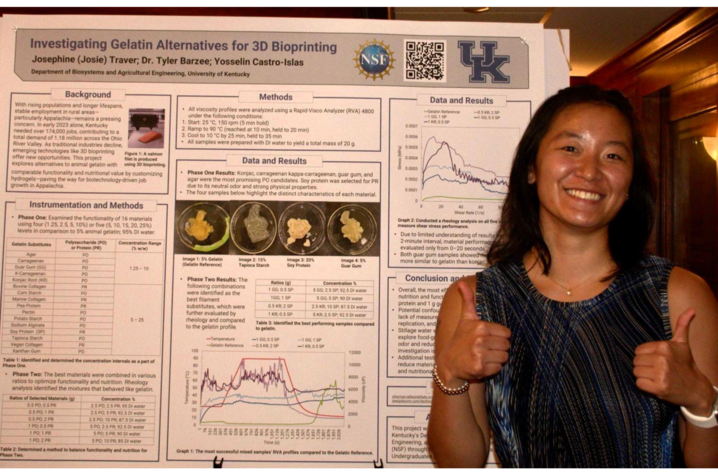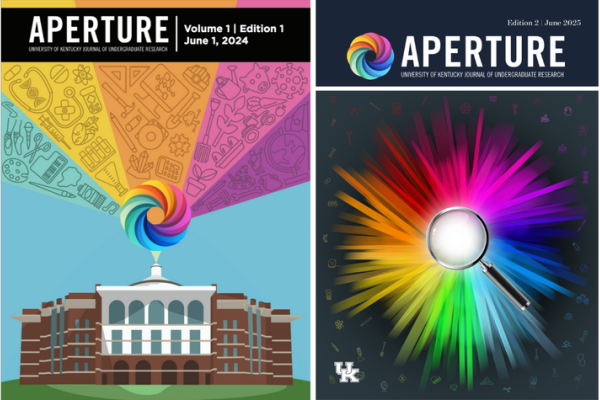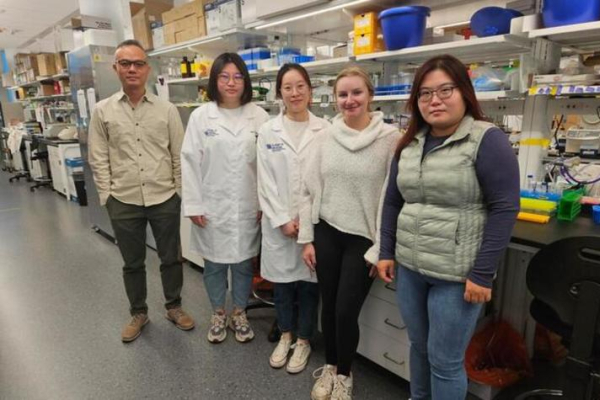UK student helping build a better base for 3D-printed foods

Josephine Traver, a Lewis Honors sophomore in chemical engineering at the University of Kentucky Stanley and Karen Pigman College of Engineering, is spending her summer turning powders and nonanimal gums into something that behaves like Jell-O — and prints like it too. She is working with the UK Martin-Gatton College of Agriculture, Food and Environment (CAFE) to hunt for a stand-in for animal gelatin, the go-to “bioink” in many 3D food printers.
“I wanted a project that mixed sustainability and curiosity,” Traver said. “Gelatin works great for printing, but it comes from animals. I wanted to see if we could get the same texture, structure and nutrition from plants instead, so we used plant-based and partially plant/animal bases to come up with a bioink that wasn’t completely animal-based.”
Her approach is methodical. Sixteen ingredients — including soy protein powder, konjac root, guar gum, tapioca starch, corn starch and some plant/animal combinations — went through the exact same lab routine using a Rapid-Visco Analyzer. That device heats and cools a sample while stirring and measuring its thickness over 35 minutes. Gelatin has a standard profile already loaded in the instrument, so Traver matched that cycle for every sample.
“Josie really impressed me in her ability to excel in a very difficult aspect of research — figuring out how to objectively screen down a huge array of options to select a few candidates for future study,” said Traver’s mentor, assistant professor Tyler Barzee, Ph.D., in the UK Department of Biosystems and Agricultural Engineering (BAE).
This work is part of UK’s Research Experiences for Undergraduates (REU), supported by a $487,000 grant the U.S. National Science Foundation. The REU brings undergraduate students from across the country together to focus on addressing water resource and engineering challenges facing the Appalachian region through research and professional development. The 2025 cohort had 12 undergraduate participants from six universities.
It also aligns with Barzee’s work combining microbiology and engineering to develop novel food products and other bioproducts from agricultural and industrial byproducts. He’s using 3D bioprinting technology in a project funded by a nearly $295,000 grant from the U.S. Department of Agriculture’s National Institute of Food and Agriculture.
“It takes persistence, curiosity, organization and a deep dedication to the scientific method to pull that off in such a short time frame,” Barzee said. “Josie certainly has a bright future ahead of her as a scholar and researcher.”
Traver’s spreadsheet tells the rest of the story: concentration, final appearance, notes and photos for every sample. She knows she needs duplicate runs to tighten the data, plus taste tests to learn what real diners think.
“We narrowed the field. Now the plan is mix-and-match ratios, repeat the best ones and make sure flavor and smell pass the sniff test — literally,” Traver said.
How does 3D food printing work?
Much like a regular 3D printer builds plastic objects layer by layer, a food printer pushes out edible mixtures — called bioinks — to create custom shapes. Instead of melted plastic, the printer uses soft, paste-like materials such as chocolate, mashed vegetables or, in this case, plant-based and partial-plant gels. A nozzle moves across a surface, squeezing out thin layers of the material in a programmed pattern. As the layers build up, they take on the shape of a familiar food like a burger patty or even a salmon fillet.
To make this work, the food “bioink” needs to be thick enough to hold its shape but soft enough to flow through the printer. That’s where gelatin usually comes in.
When Traver puts the fluids into a syringe and applies pressure with the printer, the fluids become thinner and flow through the needle into precise shapes without changing temperature. They are semi-solid gels that briefly become liquid when Traver applies pressure and then solidify immediately after depositing onto the printing space. This means she can stack them up and create complicated and precise structures that hold up.
Traver said her challenge is to find a plant-based mix that does the same job without using animal products and bring it to those in Eastern Kentucky.
“One of the reasons this research was carried out was to introduce biotechnology to Appalachia,” Traver said. “Because traditional industries such as coal mining are in decline and unemployment is high, introducing emerging technologies, such as 3D bioprinting, can increase job growth. Bringing more biotechnology, especially possible 3D-bioprinting facilities could serve as catalyst for this employment growth. These facilities can be used to deliver nutritious products to the community of Appalachia and beyond.”
Traver said she chose chemical engineering for its range, saying that it opens a lot of doors as it concentrates on things such as energy, medicine and food. Traver plans to stay in Barzee’s lab this fall.
“We’ve got a plant-based blend that gels like gelatin,” Traver said. “Now I want to make sure it tastes good, stores well and doesn’t cost a fortune. I’m excited to keep going.”
Research reported in this publication was supported by the U.S. National Science Foundation under Award No. 2348814. The opinions, findings, and conclusions or recommendations expressed are those of the author(s) and do not necessarily reflect the views of the U.S. National Science Foundation.
This material is based upon work that is supported by the National Institute of Food and Agriculture, U.S. Department of Agriculture, under award number 2023-67017-40744. Any opinions, findings, conclusions or recommendations expressed in this publication are those of the author(s) and do not necessarily reflect the view of the Department of Agriculture.
BAE is a partnership between Martin-Gatton CAFE and the Pigman College of Engineering. To learn more, visit https://bae.ca.uky.edu/.
University of Kentucky alum and former trustee Carol Martin “Bill” Gatton bestowed a transformational $100 million gift to the college through The Bill Gatton Foundation. It is the largest gift to the university in its history.
Four Pillars of The Bill Gatton Foundation’s gift are (1) Scholarships and other initiatives for Student Success, (2) Companion Animal Program, (3) 21st Century Capital Projects and New Initiatives Fund and (4) Faculty Research and Innovation/Research Challenge Trust Fund Program.


